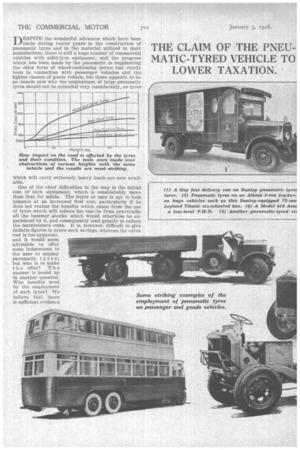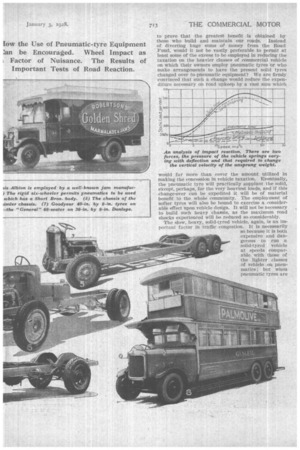THE CLAIM OF THE PNEU MATIC-TYRED VEHICLE TO
Page 50

Page 51

Page 52

Page 53

If you've noticed an error in this article please click here to report it so we can fix it.
TAtSPITU the wonderful advances which have been _Llinade during recent years in the construction of pneumatic tyres and in the material utilized in their manufacture, there is still a huge number of commercial vehicles with solid-tyre equipment, and the progress which has been made by the pneumatic in supplanting the older form of wheel-cushioning device has chiefly been in connection with passenger vehicles and the lighter classes of goods vehicle, but there appears to be no reason now why the employment of large pneumatic tyres should not be extended very considerably, as tyres which will carry extremely heavy loads are now available. to prove that the greateSt benefit is obtained by those who build and maintain our roads. Instead of diverting huge sums oil money from the Road Fund, would it not be vastly preferable to permit at least some of the excess to be employed in reducing the taxation on the heavier classes of commercial vehicle on which their owners employ pneumatic tyres 'or who make arrangements to have the present solid tyres changed over to-pneumatic equipment? We are firmly convinced that such a change would reduce the expenditure necessary on road upkeep by a vast sum which
would far more than cover the amount utilized in making the concession in vehicle taxation. Eventually, the pneumatic tyre will practically supplant the solid, eXcept, perhaps, for the very heaviest loads, and if this change-over can be expedited it will be of material benefit to the whole community. The employment of softer tyres will also be bound to exercise a considerable effect upon vehicle design. It will not be necessary to build such heavy chassis, as the maximum road shocks experienced will be reduced so-considerably.
The slow, heavy, solid-tyred vehicle, again, is an important factor in traffic congestion. It is necessarily so because it is both expensive and dangerous to run a solid-tyred vehicle at speeds comparable with those of the lighter classes of vehicle on pneumatics; but when pneumatic tyres are
used the whole problem is changed. Such a vehicle, carrying a lo'ad equivalent to that of the other, can run at practically normal traffic speeds without any additional risk—possibly, even with less risk, as pneumatic tyres can be provided with efficient non-skid treads, which is not the case with solid tyres. Such treads permit more powerful braking as well as reducing the liability to skid.
It is quite possible—and even probable—that the rigid six-Wheeler will exercise a great effect upon the employment of pneumatic tyres, as in these vehicles the weight is more evenly distributed over the axles, thus permitting the carrying of heavier loads than is normally possible.
Some of our readers may think it is all very well paying these tributes to the pneumatic tyre, but what real proof is there of the advantages which can be obtained and, in particular, as to the reduction in shocks to the road, and, consequently, of the damage incurred by both sur facing and foundation? • Some very interesting experiments were carried out about two years ago by two French engineers, with the object of analyzing the causes Of damage to roads and adjacent property by the passage of heavy vehicles. They evolved what they termed a 'factor of nuisance," this being equal to the product of the displacement of the soil expressed in one-hundredth of a millimetre and the acceleration in centimetres per second. They used accelerometers and a registering seismograph specially adapted for the experiments, and the vehicles (which were tested empty and loaded) included 3-ton and 5-ton lorries and Paris-type singledeck buses.
In all, some 1,000 experiments were carried • out, involving 2,000 measurements, which produced some startling figures. With a Saurer 3-ton lorry running at speeds of 15, 23 and 35 kiloms. per hour, the corresponding factors of nuisance on pneumatic tyres were .54, .72 and 24; on solid tyres these were increased to 1.10, 67 and 82.5. On the Paris bits, at 10; 18 and 24 kilonns. per hour, the corresponding figures were .4, .6 add .5 on pneumatics, and .6, 7.5 and 21 on solids. With a 5-ton Saurer at 16 and 26 kiloms. per hour, the factors of nuisance proved to be .4 and .8 for pneumatics and 6.7 and 61 for solids.
As will be seen, the factor on vehicles equipped with pneumatic tyres remained below unity whatever the
speed ; whereas, on solids, whilst being fairly low at slow speeds, it increased out of all proportion for the higher speeds, and the experimenters finally came to the decision that the production of fast, large-loadCapacity vehicles which will not destroy .or damage roads and buildings can only be obtained by the use of highly resilient tyres, and of these the pneumatic is the only type which has been perfected at a reasonable price.
Further experiments of vital importance have been carried out Ili:America by the Bureau of Public Roads, either alone or in co-operation with other interested associations, such as the Iowa State College and the Johns Hopkins University, and we are indebted to the Society of Automotive Engineers, Inc., of New York, for some of the information and the graphs included in this article.
For the purpose of certain road tests, vehicles were driven at different speeds over artificial obstacles of various heights and shapes, the vehicles ranging in load capacity from 1 ton to 5 tons and driven at speeds from 3 m.p.h. to 20 m.p.h.
It is of the utmost importance to note, that pneumatic tyresdid not permit an impact force greater than twice the static load -where the height of the obstruction was up to 2 ins., whereas worn solid tyres, utilized on the same vehicles, developed impact reactions of twice the static load when passing over obstructions only .15 in. in ieight. It is also most interesting to learn that with worn solid tyres the impact reaction was more than nine times the static load at the 2-in, height, and that, when new, such tyres caused only half the impact force which they did when in the worn-out condition. At speeds of between 15 m.p.h.
and 20 m.p.h. pneumatic tyres carrying 4,000 lb. per wheel did not reach impact reactions of four tons for the same test, "whereas worn solid. tyres at the same speeds, but carrying only 3,400 ll. per wheel, raised the impact reactions to nearly 20 tons.
The road impact figures of a vehicle depend mainly on four variables, these being the load per wheel, the speed, the tyre equipment and the condition of the road. The effects from variables, such as the ratio of unsprung weight to sprung weight, the flexibility of the suspension springs, and others of a .less important nature are also felt, but the manufacturing and ope.rating conditions are generally such that their effect, so far as the road is concerned, is not of major importance.
It was found during the test that the impact reaction consists of two forces acting simultaneously and .cumulatively on the road surface. One of these is the net pressure of the suspension springs at the instant of impact, its magnitude varying with the spring deflection; the other is that required to change. the vertical velocity of the unsprung weight. The difference between these forces and the total re'action caused by them can bet he compared by referring to one of the graphs. It has been found that the most severe impacts occur either when striking an obstruction or at the first rebound, or drop, after the obstruction has been passed. Appa,rently, the deciding factor in the total road reaction is that due. to the unsprung weight (without giving Consideration to the compression of the suspension springs), and at normal operating speeds it varies inversely with the cushioning qualities possessed by the tyres. The evidence proves that the cushioning above the main suspension springs can have but a very slight influence on the shocks experienced by the road, although the comfort of riding in the vehicle may be influenced considerably. s are used on (l'o be concluded.)




































































































